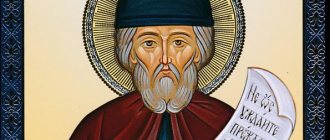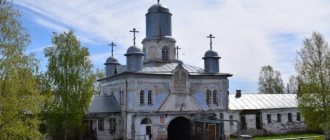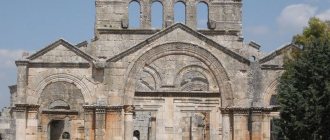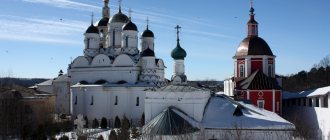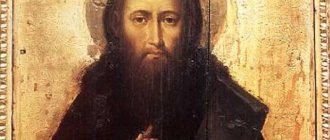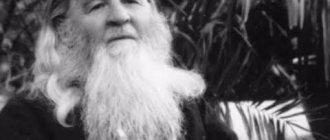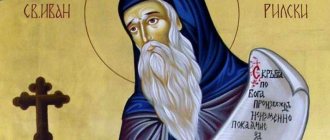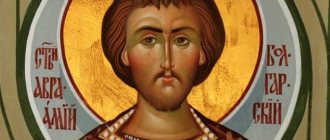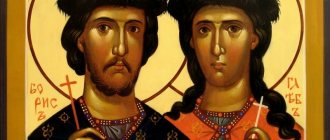Life of St. Neil Stolobensky
The Monk Nil Stolobensky was born at the end of the 15th century in the Zhabensky churchyard of the Derevskaya Pyatina of the Novgorod land; information about his parents and worldly name has not been preserved. At an early age he was orphaned and came to the Krypetsky Monastery , where he took monastic vows with the name Nil in honor of the Monk Nil the Faster . After living in the monastery for some time, Neil left it and in 1515 came to the forest near the Seremkha river, where he built himself a cell, in which he lived as a hermit for 13 years. Gradually, news about the hermit who had settled in the forest began to spread, and people began to come to the Nile for instructions and prayers. Weary of attention, in 1528 he left his Seremkh hermitage and moved to Stolobny Island on Lake Seliger .
On the island, Neil dug himself a dugout in which he lived the first winter, and in the summer he built a wooden cell and a chapel. Neil lived alone on the island for 27 years; He obtained food for himself by farming and accepted gifts of fish from fishermen who sometimes visited the island. Neil was distinguished by his special asceticism: not wanting to sleep lying down, he drove hooks into the wall of his cell and, leaning on them, rested.
The godly life of the Nile many times aroused the envy of the enemy, which manifested itself through the anger of the local residents. One day, someone set fire to the forest on the island where his hut stood, but the flames, reaching the mountain, miraculously died out. Another time, robbers broke into the hut. Neil told them: “All my treasure is in the corner of the cell.” There stood an icon of the Most Holy Theotokos . The robbers began looking for money and went blind. Then, in tears of repentance, they began to beg Nile for forgiveness.
For his burial, Neil dug a grave for himself in the chapel in advance and placed a hewn coffin in it, to which he came to lament his sins. Nile reposed on December 20, 1554. Before his death, he was visited by his spiritual father, the abbot of the St. Nicholas Rozhkov Monastery, Hegumen Sergius , who confessed and gave him communion. Arriving on the island the next day, Sergius and other monks found Nile dead and buried him.
Fighting temptations of spirit and flesh
It is known that in the first years of monasticism it is especially difficult for young monks, on whom the devil sends temptations with particular fury, turning their minds away from the thought of God with earthly passions. In order to confront the enemy with honor, Nil Stolobensky armed himself with prayer and, exhausting his flesh with fasts and vigils, prepared himself to subsequently become the chosen vessel of the Spirit of God.
The young monk had to endure a lot of labor entrusted to him by the abbot of the monastery, but no one heard a single complaint from him. For all the brethren, he was an example of meekness and goodness. Very soon the rumor about his virtues spread far beyond the walls of the monastery, and people flocked to his cell to look at the young righteous man.
Troparion and Kontakion to St. Neil of Stolobensky
Troparion, tone 8.
ABOUT! you, Father Nile, know the speed of salvation. Let us accept the cross, for you followed Christ. But whoever does and learns to despise the flesh passes away, but to practice things more immortal for the soul. In the same way the angels rejoice, O venerable spirit.
Kontakion, tone 2.
Having divinely armed yourself with spiritual purity, and unceasing prayer, as if you had firmly handed over a copy, you prosecuted the demonic host of the Nile, Our Father, pray unceasingly for all of us.
Prayer text
O great servant, glorious miracle worker, the cheerful shepherd of the flock of Christ gathered here for you and the God-given ruler of this monastery, the all-blessed Nile! With your soul in heaven stand before the Throne of God and enjoy the Trinity glory, rest with your body on earth in this Divine Temple and from it, with the grace given to you from above, you exude various miracles, look with a merciful eye on the people who are more honest than your race and who ask for your strong help. Behold, we have been defiled by immeasurable sins and constantly wallowing in the mire of passions, the righteous wrath of God has been brought upon us and we are unworthy of all mercy; In the same way, and not daring to raise our hair to the heights of heaven, to raise a prayerful voice lower, with a contrite heart and a humble spirit we call upon you for intercession and help. Therefore, as you have acquired boldness, lift up your venerable mountain with your hand, as sometimes the wonderful Moses the God-seer conquered Amalek, and extended your warm prayer to the Lord, the Creator of all and God, asking for the welfare of the Church, the blessing of the air, the fruitfulness of the earth. Deliver everyone who comes to God with undoubted faith and reverently venerates your multi-healing relics, from all mental and physical troubles, from all yearnings and excuses of the devil. Be a comforter to the sad, a physician to the sick, a helper to the afflicted, a protector to the naked, a protector to widows, a protector to the orphans, a nourisher to the baby, a strengthener to the old, a guide to the wandering, a sailing helmsman, and intercede to all who diligently require your strong help, even if it is useful for salvation. As we instruct you through your prayers, let us complete our path to the earth of our short life in comfort, let us find endless peace in heaven and together with you glorify all the good Giver, one in the Trinity glorified by God the Father and the Son and the Holy Spirit, now and ever, and unto the ages of ages. . Amen.
Reverend Neil Stolobensky. Icons
The Monk Neil is depicted full-length in monastic vestments. A large space of the icon is occupied by the image of Stolobny Island, washed by the waters of Seliger.
Reverend Neil Stolobensky. Tver, mid-17th century. Collection of N. Panitkov
Reverend Neil Stolobensky. 17th century
Reverend Neil Stolobensky. 17th century Moscow State United Art Historical-Architectural and Natural Landscape Museum-Reserve "Kolomenskoye"
The icon of St. Neil of Stolobensky from the Russian Museum differs from such works in its greater laconism of composition. It shows the central part of the monastery. The large stone five-domed Epiphany Cathedral, the refectory adjacent to the cathedral, and the high bell tower are depicted. On the north-west side, almost hidden by the image of the reverend, is the hospital church of All Saints; in the foreground, on the south side of the cathedral, is the small church of the miracle worker Nile “on the gate”. The main monastery buildings are surrounded by buildings of monastic cells.
Reverend Neil Stolobensky. Second half of the 18th century. St. Petersburg, State Russian Museum
On the icon of the Venerable Nile of Stolobensky, with the Prophet Nahum and Saint Blaise, only the main buildings of the Nile Hermitage are represented: the Epiphany Cathedral with a refectory and a bell tower, the walls and domes of which stand out against the background of the dense greenery of the forest. In the side church on the south side of the cathedral there is a shrine of St. Nile, above it there is an icon of the Most Holy Theotokos.
Venerable Nil Stolobensky, with the prophet Naum and Saint Blaise. Mid-19th century. St. Petersburg, State Russian Museum
The Venerable Nil Stolobensky is depicted on the Old Believer icon " Selected Saints ". The Nile is painted with a scroll in his hand (in the center), on the sides in a three-quarter turn to the center are the Hieromartyr Blasius and Saint Medost with books in their hands, the martyrs Florus and Laurus with scrolls.
Selected saints (Blasius, Bishop of Sebastia; Patriarch Medost of Jerusalem; Venerable Nil of Stolobensky; Saints Florus and Laurus). Moscow, second half of the 19th century. Moscow, Central Museum of Ancient Russian Culture and Art named after. Andrey Rublev
Selected saints (Medost, Blasius, Nil Stolbensky, Florus and Laurus). Second half of the 19th century. Moscow, State Research Institute of Restoration
What we did last summer
Last summer we were drawn to Seliger. Friends enticed me. We were going there for the first time, so on the way to the planned point we decided to stop first in the small town of Ostashkov, and then see Nilova Pustyn - an unforgettable landmark of this region.
You can read about Seliger Venice - the city of Ostashkov and impressions of it here.
Sculptural images of St. Neil Stolobensky
The image of St. Neil of Stolobensky received the greatest development in the form of wooden carved sculpture or bas-reliefs. In the sculptural images, “Nil Stolobensky is depicted sitting with his head bowed on his chest and leaning on wooden crutches. In such an unusual position, the exhausted old man died during prayer.” There are two traditions of such images: in the form of a sculpture with a height of 10 to 40 cm or a small carved relief of 20 by 25 cm. Such figurines were made in large quantities for pilgrims visiting the Nilo-Stolobensk hermitage. Large human-sized sculptures are also known, which were created on orders from private individuals or for chapels and churches.
Reverend Neil Stolobensky. Sculpture on the territory of the Nile Desert
Reverend Neil Stolobensky. 1770–1780s, Konyagin Kondraty Semenov (?) Ostashkov, Ascension Cathedral of the Znamensky Monastery
The three-dimensional image (Upper Volga region) is a close copy of the temple sculptural image of the Venerable Nile of Stolobensky, made in the last third of the 18th century. The flat and unpainted back side of the sculpture, as well as the hole for the mounting dowel on the lower end, indicate the original placement of the image in the icon case. This is one of the earliest known repetitions of the revered image from the Nile Desert. The creation of the monument at the end of the 18th century is indicated by the features of the style: realistically executed features of the face and figure, numerous picturesque folds of the vestment, as well as the blue pigment characteristic of this time, which is used to color the saint’s doll.
Reverend Neil Stolobensky. Upper Volga region, end of the 18th century, Collection of F. A. Kopelevich
Reverend Neil Stolobensky. First half of the 19th century. Comes from the chapel of the village of Nevskaya, Bezhetsk district, Tver province. St. Petersburg, State Russian Museum
Another sculpture, executed in the folk primitive style, goes back to the revered temple image from the Nilo-Stolobenskaya hermitage. Similar small sculptures intended for pilgrims were created by carvers from the city of Ostashkov and surrounding villages. A special feature of the published monument is the absence of crutches on which the saint leans. It is possible that the rejection of this detail was dictated by the absolute generalization of the figure’s shape, thanks to which the image achieved iconic expressiveness. The painting of vestments with polka dots is also a unique product of the author’s creativity.
Reverend Neil Stolobensky. Upper Volga region, XIX century. Collection of F. A. Kopelevich
The wooden sculpture of the Monk Nile did not develop a clear iconography (except for his pose) - “some masters depicted him as a frail old man, others as an epic hero.” It is noted that the schema of the monk on sculptures is traditionally painted black, but individual sculptures are known, painted with bright colors and gilded, while the crosses and inscriptions on the schema are in relief. The image of St. Nil Stolobensky is depicted on the coat of arms of the Firovsky district of the Tver region.
In a lonely forest cell
Shunning worldly glory, Nil Stolobensky asked for a blessing from the abbot of the monastery, Abbot Herman, and took upon himself the feat of living in the desert. Wandering for a long time through impenetrable forest thickets, he finally came to the Rzhev land, where he built himself a cell on the banks of the small river Cheremkha. Here, far from people, the future saint indulged in unceasing prayer, turning all his thoughts to the Heavenly World.
To maintain his strength, Nil Stolobensky ate what he could collect in the forest: berries, mushrooms and acorns. As he told his confessor, demons more than once tried to frighten him and force him to leave the desert. Appearing in the guise of wild animals and reptiles, the messengers of the world of darkness emitted a piercing whistle and hiss under the windows of the cell. In these cases, the hermit drove them out with the sign of the cross. It was worse when, at the instigation of demons, evil people appeared to harm him.
Nilo-Stolobenskaya desert
After the death of St. Nil, monks from various monasteries came to Stolobny Island, wandered to holy places, and lived in his cell for some time. Around 1590, the monk German Boris Kholmogorets lived at that time . With the blessing of Metropolitan Alexander of Novgorod, they built a wooden church in honor of the Epiphany with a chapel in the name of Blessed Basil, Christ for the Fool's sake. Soon a monastery with a communal charter arose, which was called the Nile Hermitage. Its first rector was the priest Herman. In 1595, the icon painter monks of the Tver Orshin Monastery of the Ascension, Job and Nifont , painted an image of the Monk Nile, which was placed on the tomb of the saint. In 1598-1600, Philotheus (Pirogov) , a monk of the Gethsemane monastery of the Trinity-Sergius Monastery, compiled stichera and a canon for the Monk Nile and wrote his Life.
Plan of the Nilo-Stolobensky Monastery at the beginning of the 19th century
In 1665, there was a fire in the monastery, all the wooden buildings, including the temple, burned down. A temporary wooden church was built for worship, and on May 27, 1667, a new stone church was founded over the tomb of St. Neil. While digging ditches for the temple, the earth crumbled, exposing the coffin; In this way, the incorruptible relics of St. Neil were discovered. His miraculous relics were transferred to a new tomb and placed in the wooden Church of the Intercession.
Nilo-Stolobenskaya desert. 1910, photo by Sergei Prokudin-Gorsky
In 1919, all church valuables were confiscated, and the relics of St. Neil were opened. The monastery operated until 1927; later it went through several changes. At the end of the 1980s, a significant part of the buildings was either lost or was in a dilapidated state. In 1990, the complex of the Nilo-Stolobenskaya Hermitage was transferred to the Russian Orthodox Church. In 1995, the relics of St. Neil were returned to the monastery.
Nilo-Stolobenskaya desert
Where do bears with candy come from?
And the forests here are surprisingly good. The rugged shores of the lake are overgrown with centuries-old pine trees. They stand under the sun, all dressed in gold, like generals on parade. The air is infused with the aroma of pine needles. The artist Ivan Shishkin wrote sketches here for “Morning in a Pine Forest” with textbook bears.
The fish splashes in the water. Grasshoppers chirp in the grass. The bird choir performs works by local feathered composers. Fairy tale…
But the navigator Ozik says that there is nothing left to the Nile Desert. And then, in the gap between the pines, domes flashed - she. We drive up the hill past the tourist complex and the endless expanse of Seliger with its white and yellow monastery looking like St. Petersburg opens up before us. Turrets, columns, granite embankments reinforcing the banks.
We parked. We go to the monastery past trade tents, boats, then a few tens of meters along a wooden bridge. Entrance is through the passage arch of the Svetlitskaya Tower. The tower was built relatively recently - in 1863. It has always served as an access gate, and now the appearance of visitors coming to the monastery is controlled here.
But she had another important role - she served as a saving beacon in bad weather. During a storm or blizzard, a lantern was lit on its spire.
Intimidating robbers
In the life of the saint, there is an incident when robbers came to him, believing that they would find money from him. Having made the sign of the cross, the ascetic came out to meet them, holding in his hands his only treasure - the image of the Most Holy Theotokos. And a miracle happened: the villains had a vision of many warriors standing behind the Nile. Frightened, the robbers fell to their knees before the saint and tearfully repented of their intentions. The humble ascetic forgave them and, having uttered an edification, sent them away in peace.
